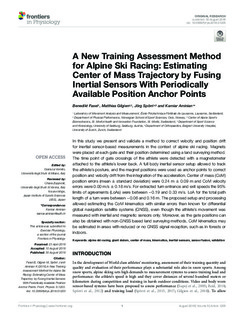| dc.contributor.author | Fasel, Benedikt | |
| dc.contributor.author | Gilgien, Matthias | |
| dc.contributor.author | Spörri, Jörg | |
| dc.contributor.author | Aminian, Kamiar | |
| dc.date.accessioned | 2019-01-03T12:43:27Z | |
| dc.date.available | 2019-01-03T12:43:27Z | |
| dc.date.created | 2018-10-08T13:09:43Z | |
| dc.date.issued | 2018 | |
| dc.identifier.citation | Frontiers in Physiology. 2018, 9, 1203. | nb_NO |
| dc.identifier.issn | 1664-042X | |
| dc.identifier.uri | http://hdl.handle.net/11250/2578971 | |
| dc.description.abstract | In this study we present and validate a method to correct velocity and position drift for inertial sensor-based measurements in the context of alpine ski racing. Magnets were placed at each gate and their position determined using a land surveying method. The time point of gate crossings of the athlete were detected with a magnetometer attached to the athlete’s lower back. A full body inertial sensor setup allowed to track the athlete’s posture, and the magnet positions were used as anchor points to correct position and velocity drift from the integration of the acceleration. Center of mass (CoM) position errors (mean ± standard deviation) were 0.24 m ± 0.09 m and CoM velocity errors were 0.00 m/s ± 0.18 m/s. For extracted turn entrance and exit speeds the 95% limits of agreements (LoAs) were between −0.19 and 0.33 m/s. LoA for the total path length of a turn were between −0.06 and 0.16 m. The proposed setup and processing allowed estimating the CoM kinematics with similar errors than known for differential global navigation satellite systems (GNSS), even though the athlete’s movement was measured with inertial and magnetic sensors only. Moreover, as the gate positions can also be obtained with non-GNSS based land surveying methods, CoM kinematics may be estimated in areas with reduced or no GNSS signal reception, such as in forests or indoors. | nb_NO |
| dc.language.iso | eng | nb_NO |
| dc.subject | alpine ski racing | |
| dc.subject | center of mass | |
| dc.subject | giant slalom | |
| dc.subject | inertial sensors | |
| dc.subject | kinematics | |
| dc.subject | sensor fusion | |
| dc.subject | validation | |
| dc.title | A new training assessment method for alpine ski racing: Estimating center of mass trajectory by fusing inertial sensors with periodically available position anchor points | nb_NO |
| dc.type | Journal article | nb_NO |
| dc.type | Peer reviewed | nb_NO |
| dc.description.version | publishedVersion | nb_NO |
| dc.rights.holder | © 2018 Fasel, Gilgien, Spörri and Aminian. This is an open-access article distributed under the terms of the Creative Commons Attribution License (CC BY). The use, distribution or reproduction in other forums is permitted, provided the original author(s) and the copyright owner(s) are credited and that the original publication in this journal is cited, in accordance with accepted academic practice. No use, distribution or reproduction is permitted which does not comply with these terms. | nb_NO |
| dc.source.journal | Frontiers in Physiology | nb_NO |
| dc.identifier.doi | 10.3389/fphys.2018.01203 | |
| dc.identifier.cristin | 1618689 | |
| dc.description.localcode | Seksjon for fysisk prestasjonsevne / Department of Physical Performance | nb_NO |
| cristin.unitcode | 150,31,0,0 | |
| cristin.unitname | Seksjon for fysisk prestasjonsevne | |
| cristin.ispublished | true | |
| cristin.fulltext | original | |
| cristin.qualitycode | 1 | |
